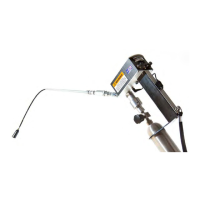
Do you have a question about the Southern Cross Flame Pack 400 Series and is the answer not in the manual?
| Gas Type | Combustible Gases |
|---|---|
| Sensor Type | Catalytic Bead |
| Detection Principle | Catalytic Oxidation |
| Detection Range | 0-100% LEL |
| Ingress Protection | IP66 |
| Output | 4-20mA |
| Weight | 1.5kg |
| Humidity Range | 0-99% RH, non-condensing |
States intellectual property rights and prohibits reproduction without consent.
Details warranty period, covered defects, and excluded items like consumables.
Describes the Flame Pack 400 as a portable hydrocarbon detector.
Specifies battery type and fuel mixture used by the instrument.
Lists physical and operational specifications like weight, reaction time, and fuel capacity.
Defines the sensitivity ranges for gas detection.
Explains how flame ionization detects hydrocarbons.
Describes the function of LED and audible alarms for flame status.
Details the ignition process and how gas presence is indicated.
Lists critical safety rules for handling and fueling the device.
Warns against use in hazardous environments and with safety features compromised.
Identifies primary parts (1-12) of the Flame Pack with their names and descriptions.
Identifies probe assembly parts (13-23) with their names and descriptions.
Detailed instructions for safely replacing the batteries.
Guidance on storing and handling batteries for optimal use.
Step-by-step guide for refilling the fuel cylinder safely.
Emphasizes the hazardous nature of the fuel mix.
Instructions for daily replacement of the primary filter.
Guidance on adding a secondary filter for dusty environments.
Outlines necessary checks before operating the instrument.
Highlights the importance of maintaining the correct device orientation.
Describes how to perform a calibration test using test gas.
Provides context on test gas usage and expected readings.
Explains how to conduct surveys for leak detection.
Details how to use different modes for gas concentration detection.
Discusses how gas leaks behave and how to interpret findings.
Steps to extinguish flame, dry cell, and close valve.
Refers to the cleaning section for maintenance.
Advice on relighting and dealing with flame outs.
Tips on avoiding damage and moisture.
Steps to follow when encountering problems.
Steps for daily cleaning of filters, probe, and case.
Steps for weekly cleaning of battery area and probe.
Method for washing and drying bronze filters.
Procedure for cleaning the device's intake system.
Addresses issues when the flame fails to light.
Addresses issues when the meter does not respond to test gas.
Important warnings regarding battery condition.
Instructions for packing and documenting units for repair.
Mandates for battery removal and fuel cylinder emptying.
Lists essential supplies like test gas and cleaning agents.
Details the precise fuel mixture and purity needed.
Lists companies for purchasing the specialized fuel.
Highlights capabilities for rugged terrain and DOT compliance.
Describes available truck-mounted survey equipment.
Describes the ease of use and portability of the kit.
Explains how to perform the calibration using the kit.